Thứ Năm, 20 tháng 8, 2015
Emperor Khai Dinh’s tomb in Hue, Vietnam
The magnificent Khai Dinh tomb is a part of Complex of Hué Monuments, on December 1993 has been recognized as a World Cultural Heritage Site by UNESCO.
Emperor Khai Dinh (1885-1925) ruled Vietnam for 9 years. His tomb took 11 years to complete. Construction began in 1920 and was completed in 1931. Under Khai Dinh, Western culture and influence began to seep into Vietnam. The king himself visited France in 1922. As a result, his tomb has many elements of Western architecture. In fact, of all the tombs, Khai Dinh’s probably least resembles oriental architecture.
The Imperial tomb of Khai Dinh Hue has been declared the most majestic imperial tomb of throughout Vietnam. Built as a monument and mausoleum, this impressive funeral tourist spot it took to build 11 years, from 1920 year to year 1931, and is the last Hue Imperial tomb.
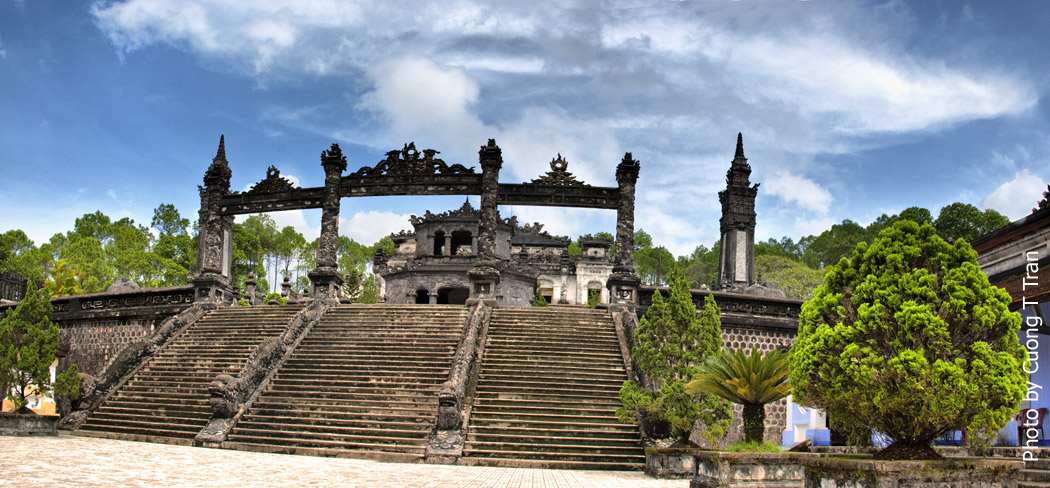 |
| Imperial Tomb of Emperor Khai Dinh |
Information about the Imperial Khai Dinh tomb
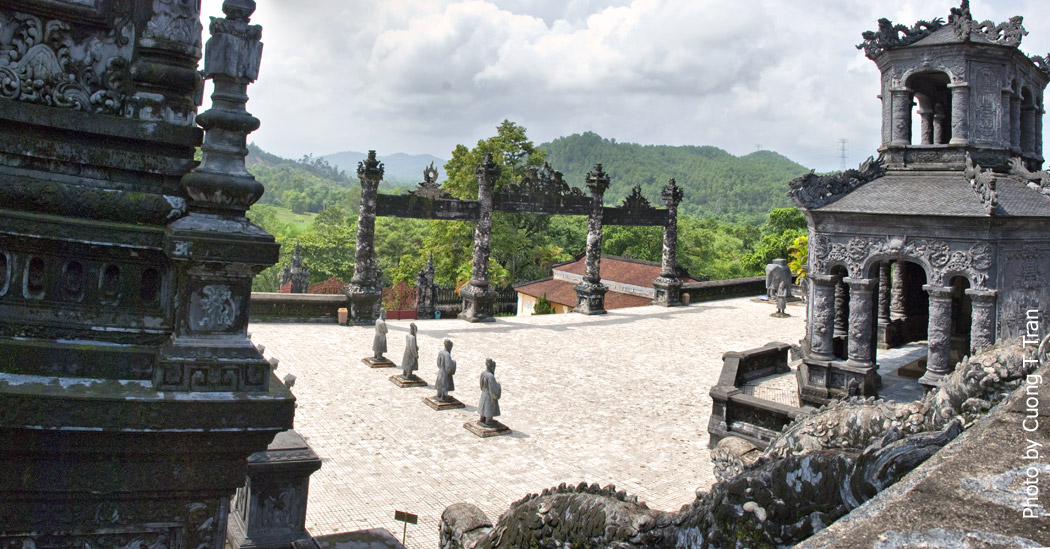
Emperor Khai Dinh (Khai Định) decided to locate his tomb imperial at the foot of the mountain Chau Chu, 9 kilometres south of the city of Hue. In comparison with the rest of imperial tombs, this imperial tomb is small in extent, little more than 5600 square meters, however its construction, decoration and details are very elaborate.
 |
| Mountain View from Chau Chu Tomb of Khai Dinh Hue Imperial |
Structure and composition of the Imperial Tomb Khai Dinh
The structure of the Imperial Khai Dinh tomb is a rectangle of 117 meters long by 48.5 meters wide, resting on the mountain Chau Chu. Khai Dinh tomb is constructed largely of reinforced concrete and the imperial tomb of Hue has more Western influences.
The imperial tomb has 2 very different parts: the Palace Thien Dinh, where we can see the sarcophagus of Emperor Khai Dinh, and the outside of the Tomb Imperial, where statues of the courtyard of ceremonies, theHouse of mandarins and Pavilion of steles, hexagonal-shaped, is most remarkable.
Outside of Khai Dinh Hue Imperial Tomb
Upon crossing the gateway to the imperial Tomb, we find 37 steps whose railings have been carved in the shape of dragons, these dragons are the largest of all Vietnam.
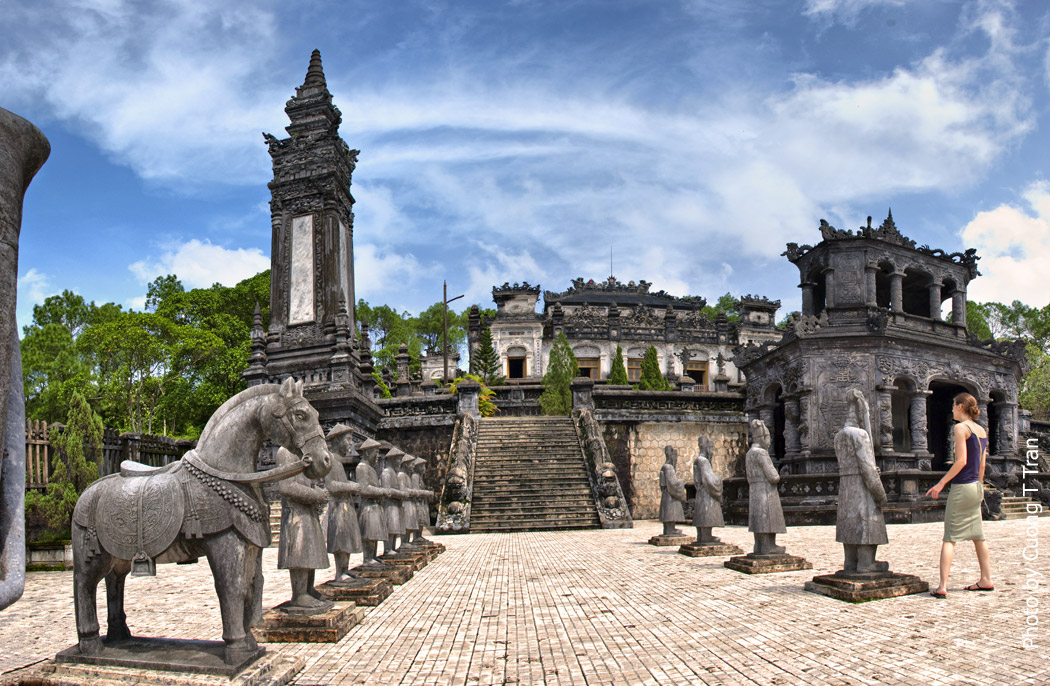 |
| Ladder and dragon-shaped handrail – Imperial Tomb Khai Dinh |
Once you have uploaded the steps, we will find ourselves with a small courtyard with houses of the mandarins on both sides. To access the next part of the Hue Imperial Khai Dinh Tomb, we will have to climb other 29 steps, this is one of the most beautiful points of the visit, the courtyard of ceremonies, with stone statues (rare material in this imperial tomb), which unlike the rest of Hue imperial tombs, has 2 rows of statueswhere the second row are the bodyguards of the emperor.
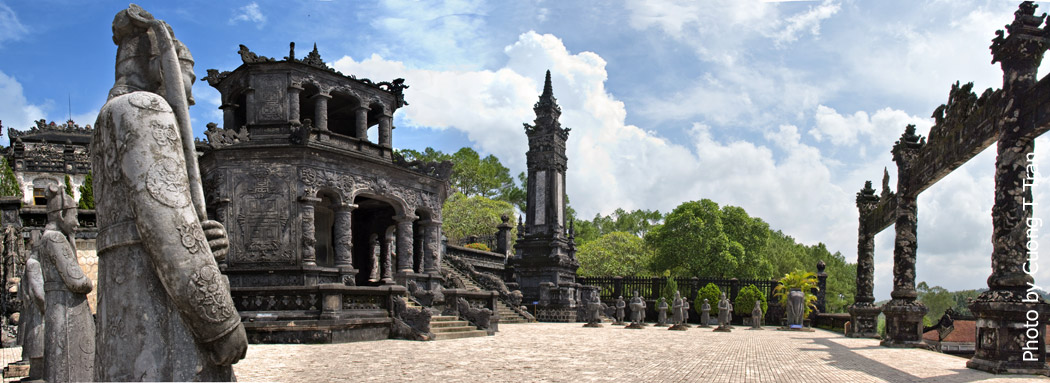 |
| Stone statues in the courtyard of the tomb ceremonies |
In that same place of the Tomb in the courtyard of ceremonies, we have the stele Pavilion, with a Stela engraved in stone on the life and reign of the emperor. This monument is unique, as is the single flag of the stelae of all Hue imperial tombs whose shape is hexagonal.
Dinh Thien Palace
The last part of the complex Khai Dinh, to the top of the Imperial Tomb, is the Thien Dinh Palace, where we can see the sarcophagus of Emperor. This Palace of the imperial tomb is formed by several ranches communicated among themselves, where the main hall contains a statue of the seated Emperor Khai Dinh upon his throne and at his feet, his sarcophagus. The decoration is made with stained glass and mosaics built ceramic based broken into pieces.
As a curiosity, we know that the sun is directly behind the statue of the emperor, the emperor’s death represents.
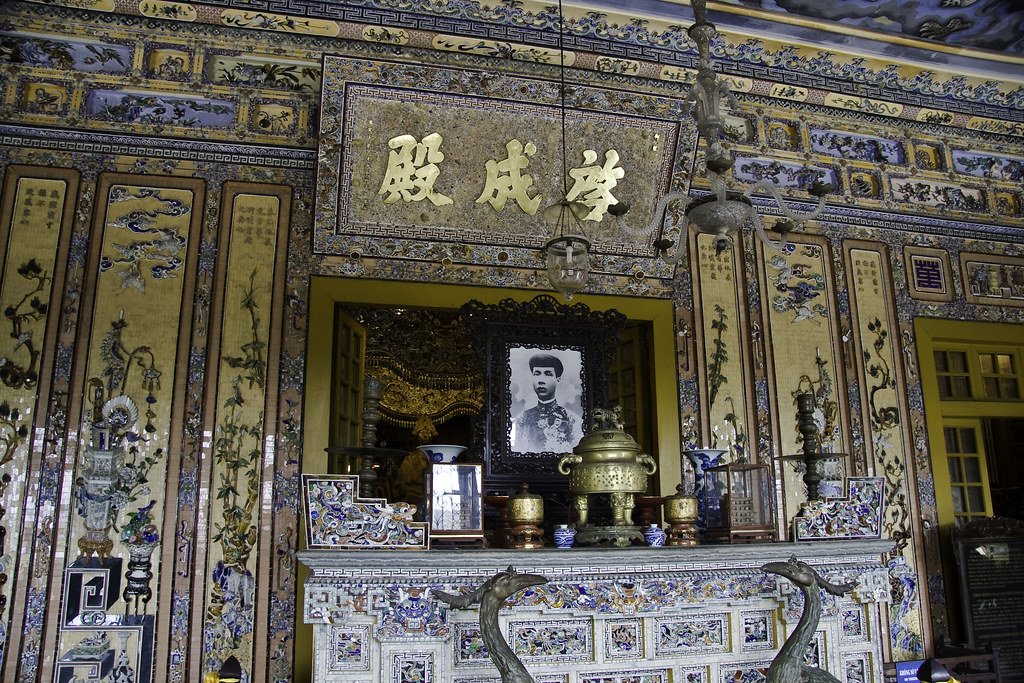
Sarcophagus of Emperor Khai Dinh Hue (Vietnam)
In the room next to the sarcophagus room, we have a statue of Emperor Khai Dinh, scale, made of bronze.
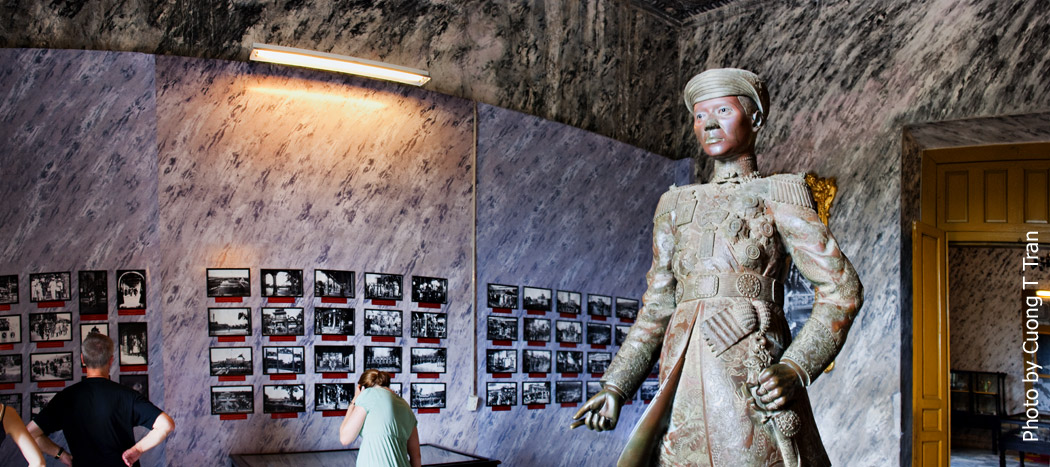
Statue of Emperor Khai Dinh Hue
Architectural influences of the Imperial Tomb Khai Dinh Hue
Imperial Khai Dinh ‘s tomb is unique with respect to other imperial tombs in Hue by their influences and mix of architectural styles, for example:
Influence India: in the top finishes of gates, towers and obelisks
Romanesque influence: the Pavilion of steles in hexagonal shape
Facts about the Emperor Khai Dinh
Emperor Khai Dinh had a close relationship with the French occupiers, who did not like nothing to the Vietnamese people and behavior which earned the Emperor Khai Dinh the nickname of French employee.
Khai Dinh died at age 40 of tuberculosis, which his son had to finish the construction of the Imperial Tomb Khai Dinh.
Facts about Imperial Khai Dinh ‘s tomb
The cost of construction of the Imperial Khai Dinh tomb was such, that the Emperor raised taxes to the Vietnamese village by 30%.

Ceramics in the Imperial Tomb of Khai Dinh Hue
The imperial tomb of Khai Dinh is so elaborate and with so many details, Khai Dinh , he had to go to the French to buy steel, iron, cement and tiles. The emperor also sent ships to China and Japan to achieve ceramics and stained glass needed for the Tomb. things to do in hanoi
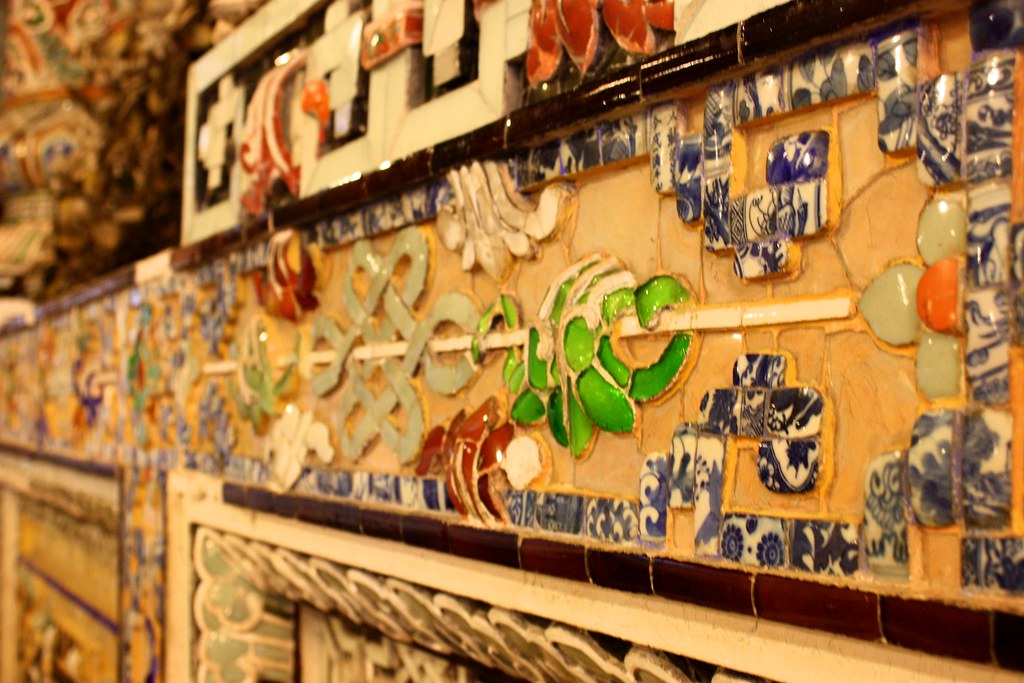
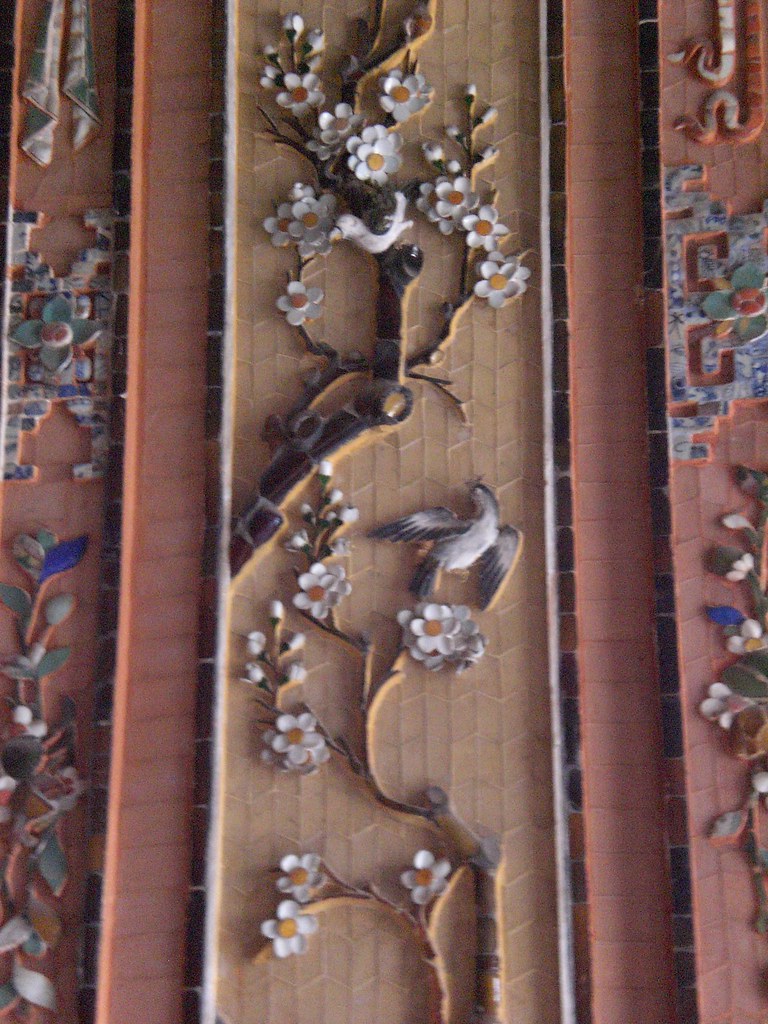
When to get there
All tourist sites in here are opened all year long. Entrance fee is even free on big holidays such as the first of Lunar New Year and National Day (September 2nd). Khai Dinh Tomb opens from 7.30AM to 5.00AM Read more thing to do in dalat
How to get there
The tomb is about 7km away from the center of Hue city. Travellers are recommended to get there by motorbike or taxi.
Đăng ký:
Đăng Nhận xét
(
Atom
)

Không có nhận xét nào :
Đăng nhận xét